《儿科学》课程教学大纲 Teaching Outline for Pediatrics Course(英文)
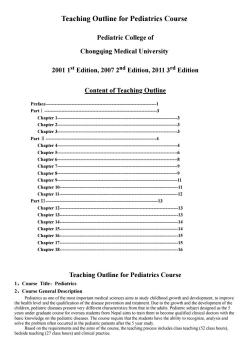
Teaching Outline for Pediatrics CoursePediatric College ofChongqing Medical University2001 1st Edition, 2007 2nd Edition, 2011 3rd EditionContent of Teaching OutlinePreface13Part IChapter 1Chapter 2-33Chapter 3-Part IIChapter 4-4-6Chapter 5--8Chapter 6--9 Chapter 7--9Chapter 8-Chapter 9--11Chapter 10-Chapte 1I--12-13 Part III--13Chapter 12-13Chapter 13.--14Chapter 14-Chapter 15-Chapter 16-15 Chapter 17---16Chapter 18-Teaching Outline for Pediatrics Course1, Course Title: Pediatrics2, Course General DescriptionPediatricsasoneofthemost important medicalsciencesaimstostudychildhoodgrowthanddevelopment,toimprovehhhaieationodoaeeyearsundergraduatecourseforoverseasdentsfromNalmtotranhmomqualifiedclinicaldoctorswiththesickwledohdiatidsaseshourrqurthathsudenshaabilirognizaayisasn dsh,bedside teaching (27classhours)and clinical practice
Teaching Outline for Pediatrics Course Pediatric College of Chongqing Medical University 2001 1 st Edition, 2007 2 nd Edition, 2011 3 rd Edition Content of Teaching Outline Preface-1 PartⅠ-3 Chapter 1-3 Chapter 2-3 Chapter 3-3 Part Ⅱ-4 Chapter 4-4 Chapter 5-6 Chapter 6-8 Chapter 7-9 Chapter 8-9 Chapter 9-11 Chapter 10-11 Chapter 11-12 Part Ⅲ-13 Chapter 12-13 Chapter 13-13 Chapter 14-14 Chapter 15-14 Chapter 16-15 Chapter 17-15 Chapter 18-16 Teaching Outline for Pediatrics Course 1、Course Title:Pediatrics 2、Course General Description Pediatrics as one of the most important medical sciences aims to study childhood growth and development, to improve the health level and the qualification of the disease prevention and treatment. Due to the growth and the development of the children, pediatric diseases present very different characteristics from that in the adults. Pediatric subject designed as the 5 years under graduate course for oversea students from Nepal aims to train them to become qualified clinical doctors with the basic knowledge on the pediatric diseases. The course require that the students have the ability to recognize, analysis and solve the problem often occurred in the pediatric patients after the 5 year study. Based on the requirements and the aims of the course, the teaching process includes class teaching (52 class hours), bedside teaching (27 class hours) and clinical practice
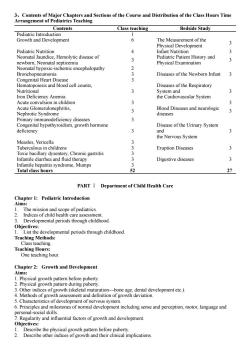
3, Contents of Major Chapters and Sections of the Course and Distribution of the Class Hours TimeArrangement ofPediatrics TeachingContentsClass teachingBedside StudyPediatric Introduction16The Measurement of theGrowth and Development3Physical DevelopmentPediatric Nutrition43Infant NutritionNeonatal Jaundice, Hemolytic disease ofPediatric Patient History and33newborn,NeonatalsepticemiPhysicalExamination233Neonatal hypoxic-ischemic encephalopathyDiseases of the Newborn InfantBronchomonianeurCongenital Heart Dismatopoiesis and blood cellcountsDiseases of the Respiratory3VutriSysteman3Iron Deficiency Anemithe Cardiovascular SystemAcuteconvulsion inchildren33Blood Diseases and neurologicAcute Glomerulonephritis,33NephroticSyndromediseasePrimary immunodeficiency diseases3Congenital hypothyroidism,growth hormoneDisease of the Urinary System33deficiencyanothe Nervous SystemMeasles, Vericella3333Tuberculous in childrensEruption DiseasesToxic bacillary dysentery,Chronic gastris3332Digestive diseasesInfantilediarrhea and fluid therapyInfantile hepatitis syndrome, Mumps27Total class hoursPART I Department of Child Health CareChapter 1: Pediatric IntroductionAimsThe mission and scope of pediatrics.Indices of child healthcareasseDevelopmental periods through childhood.ObjectiList the developmental periods through childhood.Teaching Methods: Class teaching.Teaching Hours:One teaching hourChapter 2: Growth and DevelopmentAims1. Physical growth pattern before puberty2.Physical growth patterrpuberty3. Other indices of growth (skeletal maturationbone age, dental development etc.)4. Methods ofsment and definition ofgrowth deviation5.Characteristics of developmmentof nervous system6. Principles and milestones of normal development including sense and perception, motor, language andpersonal-social skills7.Regularity and influential factors of growth and development.Objectives:Describe the physical growth pattern before puberty.Describe other indices of growth and their clinical implications
3、Contents of Major Chapters and Sections of the Course and Distribution of the Class Hours Time Arrangement of Pediatrics Teaching Contents Class teaching Bedside Study Pediatric Introduction 1 Growth and Development 6 The Measurement of the Physical Development 3 Pediatric Nutrition 4 Infant Nutrition 3 Neonatal Jaundice, Hemolytic disease of newborn, Neonatal septicemia 3 Pediatric Patient History and Physical Examination 3 Neonatal hypoxic-ischemic encephalopathy 2 Bronchopneumonia 3 Diseases of the Newborn Infant 3 Congenital Heart Disease 3 Hematopoiesis and blood cell counts, Nutritional Iron Deficiency Anemia 3 Diseases of the Respiratory System and the Cardiovascular System 3 Acute convulsion in children 3 3 Acute Glomerulonephritis, Nephrotic Syndrome 3 Blood Diseases and neurologic diseases 3 Primary immunodeficiency diseases 3 Congenital hypothyroidism, growth hormone deficiency 3 Disease of the Urinary System and the Nervous System 3 Measles, Vericella 3 Tuberculous in childrens 3 Eruption Diseases 3 Toxic bacillary dysentery, Chronic gastritis 3 Infantile diarrhea and fluid therapy 3 Digestive diseases 3 Infantile hepatitis syndrome, Mumps 3 Total class hours 52 27 PART Ⅰ Department of Child Health Care Chapter 1: Pediatric Introduction Aims: 1. The mission and scope of pediatrics. 2. Indices of child health care assessment. 3. Developmental periods through childhood. Objectives: 1. List the developmental periods through childhood. Teaching Methods: Class teaching. Teaching Hours: One teaching hour. Chapter 2: Growth and Development Aims: 1. Physical growth pattern before puberty. 2. Physical growth pattern during puberty. 3. Other indices of growth (skeletal maturation—bone age, dental development etc.). 4. Methods of growth assessment and definition of growth deviation. 5. Characteristics of development of nervous system. 6. Principles and milestones of normal development including sense and perception, motor, language and personal-social skills. 7. Regularity and influential factors of growth and development. Objectives: 1. Describe the physical growth pattern before puberty. 2. Describe other indices of growth and their clinical implications
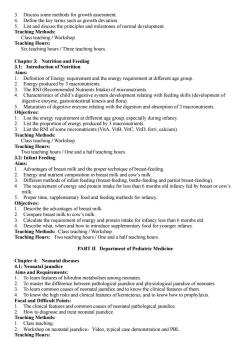
Discuss some methods for growth assessment.Define the key terms such as growth deviationList and discuss the principles and milestones of normal development.Teaching MethocClass teaiching /Workshop.Teaching HoursSix teaching hours / Three teaching hoursChapter 3: Nutrition and Feeding3.1:Introduction of NutritionAimsDefinition of Enerequirement and theerequirement at different age groupducedby3maEnergyponutrienThe RNI (Recommended Nutrients Intake) of micronutrientristics of child's digestive system development relating with feeding skills (development ofharagastrointestinal kinesis and flora)e enzyme relating with the digestion and absorption of3 macronutrientsMaofdigestObjectiveList the energy requirement at different age group, especially during infancy.List theproportion of energyproduced by3macronutrients.ist the RNI of some micronutrients (VitA, VitB, VitC, VitD, ferri, calcium).Teaching MethodsClass teaching / Workshop.Teaching Hoursrs / One and a half teaching hours3.2: Infant FeedingAimAdvantages of breast milk and the proper technique of breast-feeding.Energy and nutrient composition in breast milk and cow's milkDifferent methods of infant feeding (breast-feeding, bottle-feeding and partial breast-feeding).The requirement of energy and protein intake for less than 6 months old infancy fed by breast or cow'smilkProper time, supplementary food and feeding methods for infancyObjectivesges of breast milk.hetheaoSommiCalculate the requirement of energy and protein intake for infancy less than 6 months old.1Describe what, when and how to introduce supplementary food for younger infancy.Teaching Methods: Class teaching /WorkshopTeaching Hours: Two teaching hours / One and a half teaching hours.PART II Department of Pediatric MedicineChapter 4: Neonatal diseases4.l:Neonatal jaundiceAims and RequiremennirbinmetabolisneonatedphvsiologicaljaureonatesTolearn common causes of neonatal jaundice and toknowtheclinical featuresof thenTo know the high risks and clinical features of kernicterus, and to know how to prophylaxis.Focal and Difficult PointsThe clinical features and common causes of neonatal pathological jaundice5Howgnoseandtreat neonatal jaundiceTeaching MetthodClass teaching.Workshoponneonatal jaundiceVideo,typicalcasedemonstrationandPBLTeaching Hour
3. Discuss some methods for growth assessment. 4. Define the key terms such as growth deviation. 5. List and discuss the principles and milestones of normal development. Teaching Methods: Class teaching / Workshop. Teaching Hours: Six teaching hours / Three teaching hours. Chapter 3: Nutrition and Feeding 3.1: Introduction of Nutrition Aims: 1. Definition of Energy requirement and the energy requirement at different age group. 2. Energy produced by 3 macronutrients. 3. The RNI (Recommended Nutrients Intake) of micronutrients. 4. Characteristics of child’s digestive system development relating with feeding skills (development of digestive enzyme, gastrointestinal kinesis and flora). 5. Maturation of digestive enzyme relating with the digestion and absorption of 3 macronutrients. Objectives: 1. List the energy requirement at different age group, especially during infancy. 2. List the proportion of energy produced by 3 macronutrients. 3. List the RNI of some micronutrients (VitA, VitB, VitC, VitD, ferri, calcium). Teaching Methods: Class teaching / Workshop. Teaching Hours: Two teaching hours / One and a half teaching hours. 3.2: Infant Feeding Aims: 1. Advantages of breast milk and the proper technique of breast-feeding. 2. Energy and nutrient composition in breast milk and cow’s milk. 3. Different methods of infant feeding (breast-feeding, bottle-feeding and partial breast-feeding). 4. The requirement of energy and protein intake for less than 6 months old infancy fed by breast or cow’s milk. 5. Proper time, supplementary food and feeding methods for infancy. Objectives: 1. Describe the advantages of breast milk. 2. Compare breast milk to cow’s milk. 3. Calculate the requirement of energy and protein intake for infancy less than 6 months old. 4. Describe what, when and how to introduce supplementary food for younger infancy. Teaching Methods: Class teaching / Workshop. Teaching Hours: Two teaching hours / One and a half teaching hours. PART Ⅱ Department of Pediatric Medicine Chapter 4: Neonatal diseases 4.1: Neonatal jaundice Aims and Requirements: 1. To learn features of bilirubin metabolism among neonates. 2. To master the difference between pathological jaundice and physiological jaundice of neonates. 3. To learn common causes of neonatal jaundice and to know the clinical features of them. 4. To know the high risks and clinical features of kernicterus, and to know how to prophylaxis. Focal and Difficult Points: 1. The clinical features and common causes of neonatal pathological jaundice. 2. How to diagnose and treat neonatal jaundice. Teaching Methods: 1. Class teaching. 2. Workshop on neonatal jaundice:Video, typical case demonstration and PBL. Teaching Hours:
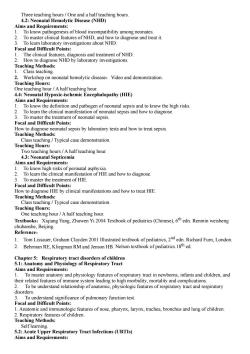
Three teaching hours / One and a half teaching hours4.2: Neonatai Hemolytic Disease (NHD)Aims and Requirementsogenesisof bloodincompatibilityamongneonateoknowpaclinicalfeatures ofNHD,andHwtodiagnoseand treat itTomastervestigations about NHD.Focal and Difficult PointsThe clinical features, diagnosis and treatment ofNHDHow to diagnose NHD by laboratory investigations.2Teaching MethodsClass teaching.2Workshop on neonatal hemolytic disease:Video and demonstration.Teaching Hoursr/Ahalfteachinghouneteachir4.4: Neonatal Hypoxic-ischemic Encephalopathy (HIE)n and pathogen of neonatal sepsis and to know the high risksToknowtheitiTolearntheclinical manifestatioon ofneonatal sepsis and howtodiagnoseTo master the treatment of neonatal sepsisFocal and Difficult PointsHow to diagnlose neonatal sepsis by laboratory tests and how to treat sepsisTeaching MethodsClass teaching / Typical case demonstrationTeaching Hourshalf teaching hour4.3: NconatalAims and RequirementsToknowhigh risks of perinatal asphyxiaTo learn the clinical manifestation of HIE and how to diagnose.atmentof HIEomasterthetreaFocal and Difficult PoinHow to diagnose HIE by clinical manifestations and how to treat HIELeachinghVethodlTypical case demonstration.lang/TeaOne teaching hour / A half teaching hourTextbooks: Xiqiang Yang, Zhuwen Yi 2004 Textbook of pediatrics (Chinese), 6th edn. Renmin weishengchubanshe,Beijing.Referenceom Lssauer, Graham Clayden20llustrated textbookof pediatrics, 2nd edn Richard Furn, LondonBehrman RE, Kliegman RM and Jenson HB. Nelson textbook of pediatrics.18th edChapter 5: Respiratory tract disorders of children5.1:Anatomy and Physiology of Respiratory TractAims and Requirements master anatomy and physiology features of respiratory tract in newborns, infants and children, andtheirrelatedorbiditymortalityandcomplicatiorfeafuressvsteeadingtohighmorunderstand relationship of anatomic,physiologic features of respiratory tract and respiratorydisorderTo understand significance of pulmonary function test.Focal and Difficult Points. Anatomic and immunologic features of nose, pharynx, larynx, trachea, bronchus and lung of children2.Respiratory features of childrenTeachingMethods:elf learning5.2: Acute Upper Respir:ory Tract Infections (URTISs)Aims and Requirements
Three teaching hours / One and a half teaching hours. 4.2: Neonatal Hemolytic Disease (NHD) Aims and Requirements: 1. To know pathogenesis of blood incompatibility among neonates. 2. To master clinical features of NHD, and how to diagnose and treat it. 3. To learn laboratory investigations about NHD. Focal and Difficult Points: 1. The clinical features, diagnosis and treatment of NHD. 2. How to diagnose NHD by laboratory investigations. Teaching Methods: 1. Class teaching. 2. Workshop on neonatal hemolytic disease:Video and demonstration. Teaching Hours: One teaching hour / A half teaching hour. 4.4: Neonatal Hypoxic-ischemic Encephalopathy (HIE) Aims and Requirements: 1. To know the definition and pathogen of neonatal sepsis and to know the high risks. 2. To learn the clinical manifestation of neonatal sepsis and how to diagnose. 3. To master the treatment of neonatal sepsis. Focal and Difficult Points: How to diagnose neonatal sepsis by laboratory tests and how to treat sepsis. Teaching Methods: Class teaching / Typical case demonstration. Teaching Hours: Two teaching hours / A half teaching hour. 4.3: Neonatal Septicemia Aims and Requirements: 1. To know high risks of perinatal asphyxia. 2. To learn the clinical manifestation of HIE and how to diagnose. 3. To master the treatment of HIE. Focal and Difficult Points: How to diagnose HIE by clinical manifestations and how to treat HIE. Teaching Methods: Class teaching / Typical case demonstration. Teaching Hours: One teaching hour / A half teaching hour. Textbooks:Xiqiang Yang, Zhuwen Yi 2004 Textbook of pediatrics (Chinese), 6th edn. Renmin weisheng chubanshe, Beijing. Reference: 1. Tom Lissauer, Graham Clayden 2001 Illustrated textbook of pediatrics, 2nd edn. Richard Furn, London. 2. Behrman RE, Kliegman RM and Jenson HB. Nelson textbook of pediatrics.18th ed. Chapter 5: Respiratory tract disorders of children 5.1: Anatomy and Physiology of Respiratory Tract Aims and Requirements: 1. To master anatomy and physiology features of respiratory tract in newborns, infants and children, and their related features of immune system leading to high morbidity, mortality and complications. 2. To be understand relationship of anatomic, physiologic features of respiratory tract and respiratory disorders. 3. To understand significance of pulmonary function test. Focal and Difficult Points: 1. Anatomic and immunologic features of nose, pharynx, larynx, trachea, bronchus and lung of children. 2. Respiratory features of children. Teaching Methods: Self learning. 5.2: Acute Upper Respiratory Tract Infections (URTIs) Aims and Requirements:
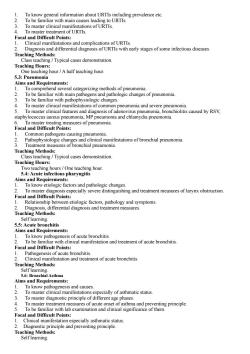
To know general information about URTIs including prevalence etc.1.2To be familiar with main causes leading to URTIstions ofURTIsmasterclinicamatofURTIsFocal and Difficult PoinClinical manifestations and complications of URTIsDiagnosis and differential diagnosis ofURTIs with early stages of some infectious diseasesTeaching MethodsClass teaching /Typical cases demonstration.Teaching HoursOne teaching hour / A half teaching hour.5.3: PneumoniaAims and Requirementategorizing methods of pneumoniaiarwithmainnd pathologic changes of pneumoniaTo befamiliar with pathophysiologic changeTo master clinical manifestations of common pneumonia and severe pneumoniao master clinical features and diagnosis of adenovirus pneumonia. bronchiolitis caused by RsVstaphylococcus aureus pneumonia, MP pneumonia and chlamydia pneumoniatreatinmeasuresofpneumonia.Focal and Difficult CommonpathogenscausingpneumonianifestationsofbronchialpneumoniaohyTresofbronchialpneumoniaTeaching MethodscaClass teaching/Typical cases demonstration.Teaching HoursTwo teaching hours / One teaching hour5.4:Acute infectious pharyngitisAims and Requirementsndpathologicchangesoknovetiologicfactorssis especially severe distinguishing and treatment measures of larynx obstructionFocal and Difficult PoinRelationship between etiologic factors, pathology and symptomsDiagnosis, differential diagnosis and treatment measures.Teaching Methods:Self learning.5.5: Acute bronchitisAims and Requirementsisof acutebronchitishooennowbatclinical manifestation and treatment of acute bronchitisFocal and Difficult Pointis of acute bronchitisPathogenesClinical manifestation and treatment of acute bronchitis.Teaching Methods:Self learnir5.6:BronchialAsthmegurenTo master clinical manifestations esspecially of asthmatic statusTo master diagnostic principle of different age phasesTo master treatment measures of acute onset of asthma and preventing principle.befamiliarwithlabexaminationandclinical significanceofthemFocal and Difficult Pointsinical manifestation especially asthmatic status.Diagnostic principle and preventing principle.Teaching MethodsSelf learning
1. To know general information about URTIs including prevalence etc. 2. To be familiar with main causes leading to URTIs. 3. To master clinical manifestations of URTIs. 4. To master treatment of URTIs. Focal and Difficult Points: 1. Clinical manifestations and complications of URTIs. 2. Diagnosis and differential diagnosis of URTIs with early stages of some infectious diseases. Teaching Methods: Class teaching / Typical cases demonstration. Teaching Hours: One teaching hour / A half teaching hour. 5.3: Pneumonia Aims and Requirements: 1. To comprehend several categorizing methods of pneumonia. 2. To be familiar with main pathogens and pathologic changes of pneumonia. 3. To be familiar with pathophysiologic changes. 4. To master clinical manifestations of common pneumonia and severe pneumonia. 5. To master clinical features and diagnosis of adenovirus pneumonia, bronchiolitis caused by RSV, staphylococcus aureus pneumonia, MP pneumonia and chlamydia pneumonia. 6. To master treating measures of pneumonia. Focal and Difficult Points: 1. Common pathogens causing pneumonia. 2. Pathophysiologic changes and clinical manifestations of bronchial pneumonia. 3. Treatment measures of bronchial pneumonia. Teaching Methods: Class teaching / Typical cases demonstration. Teaching Hours: Two teaching hours / One teaching hour. 5.4: Acute infectious pharyngitis Aims and Requirements: 1. To know etiologic factors and pathologic changes. 2. To master diagnosis especially severe distinguishing and treatment measures of larynx obstruction. Focal and Difficult Points: 1. Relationship between etiologic factors, pathology and symptoms. 2. Diagnosis, differential diagnosis and treatment measures. Teaching Methods: Self learning. 5.5: Acute bronchitis Aims and Requirements: 1. To know pathogenesis of acute bronchitis. 2. To be familiar with clinical manifestation and treatment of acute bronchitis. Focal and Difficult Points: 1. Pathogenesis of acute bronchitis. 2. Clinical manifestation and treatment of acute bronchitis. Teaching Methods: Self learning. 5.6: Bronchial Asthma Aims and Requirements: 1. To know pathogenesis and causes. 2. To master clinical manifestations especially of asthmatic status. 3. To master diagnostic principle of different age phases. 4. To master treatment measures of acute onset of asthma and preventing principle. 5. To be familiar with lab examination and clinical significance of them. Focal and Difficult Points: 1. Clinical manifestation especially asthmatic status. 2. Diagnostic principle and preventing principle. Teaching Methods: Self learning
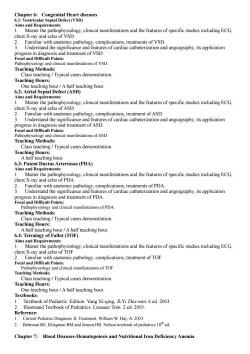
Chapter 6: Congenital Heart diseasesar Septal Defect (VSD)6.1:VentricularMasterhepathhyolinicalmanfestatons andthefatursfsisdes includingGchest X-ray and echo of VSD.Familiar with anatomic pathology, complications, treatments of VSD.Understand the significance and features of cardiac catheterization and angiography, its applicationprogress in diagnosis and treatment of VSD.Pathophysiology and clinical manifestations ofVSDTeaching MethodsClass teaching / Typical cases demonstration.Teaching Hours:teaching hour./AOneteachingh6.2:AtriaSeptalDefect(ASD)imMastethe pathophyioogycinicalmanifestations andthfeauresseifcsdies includingGchest X-ray and echo of ASD.Familiar with anatomic pathology, complications, treatment of ASDUnderstand the significance and features of cardiac catheterization and angiography, its applicationagnosis and treatmentof ASDprogress iPathophysiology and clinical manifestations ofASDTeaching MethodsClassteaching/Typical cases demonstrationTeaching HoursA half teaching hou6.3:PatentDuctusArteriosus(PDA)LimsaMasterthe pathophyioogyclinicalmanifestations andthefeauresfsifsudies includingGchest X-ray and echo of PDAFamiliar with anatomic pathology,complications, treatments ofPDAUnderstand the significance andfeatures of cardiac catheterization and angiography,its applicationn diagnosis and treatment of PDA.progress331Pathophysiology and clinicalmanifestationsofPDATeaching Methods:Class teaching /Typical cases demonstration.TeacloH0Ahalf teachinghalf teachinghour54.7TOEAims and RequirementMaster the pathophysiology, clinical manifestations and thefeatures of specific studies including ECGchest X-ray and echo of TOFFamiliar with anatomic pathology, complications, treatment of TOFFoond clinicalmanifestationsofTOFTeaching MethodsClass teaching/Typical cases demonstration.Teaching HOne teaching hour / A half teaching hour.TextbookTextbook of Pediatnion. Yang Xi-qing, & Yi Zhu-vEditiwen. 6 ed. 2003Illustrated Textbook of Pediatrics.LissauerTom.2 ed.2001ReferenceCurrent Pediatric Diagnosis & Treatment. William W. Hay,Jr.2003.Behrman RE, Kliegman RM and Jenson HB.Nelson textbook of pediatrics.18th eChapter 7:Blood Diseases-Hematopoiesis and Nutritional Iron Deficiency Anemia
Chapter 6: Congenital Heart diseases 6.1: Ventricular Septal Defect (VSD) Aims and Requirements: 1. Master the pathophysiology, clinical manifestations and the features of specific studies including ECG, chest X-ray and echo of VSD. 2. Familiar with anatomic pathology, complications, treatments of VSD. 3. Understand the significance and features of cardiac catheterization and angiography, its application progress in diagnosis and treatment of VSD. Focal and Difficult Points: Pathophysiology and clinical manifestations of VSD. Teaching Methods: Class teaching / Typical cases demonstration. Teaching Hours: One teaching hour / A half teaching hour. 6.2: Atrial Septal Defect (ASD) Aims and Requirements: 1. Master the pathophysiology, clinical manifestations and the features of specific studies including ECG, chest X-ray and echo of ASD. 2. Familiar with anatomic pathology, complications, treatment of ASD. 3. Understand the significance and features of cardiac catheterization and angiography, its application progress in diagnosis and treatment of ASD. Focal and Difficult Points: Pathophysiology and clinical manifestations of ASD. Teaching Methods: Class teaching / Typical cases demonstration. Teaching Hours: A half teaching hour. 6.3: Patent Ductus Arteriosus (PDA) Aims and Requirements: 1. Master the pathophysiology, clinical manifestations and the features of specific studies including ECG, chest X-ray and echo of PDA. 2. Familiar with anatomic pathology, complications, treatments of PDA. 3. Understand the significance and features of cardiac catheterization and angiography, its application progress in diagnosis and treatment of PDA. Focal and Difficult Points: Pathophysiology and clinical manifestations of PDA. Teaching Methods: Class teaching / Typical cases demonstration. Teaching Hours: A half teaching hour / A half teaching hour. 6.4: Tetralogy of Fallot (TOF) Aims and Requirements: 1. Master the pathophysiology, clinical manifestations and the features of specific studies including ECG, chest X-ray and echo of TOF. 2. Familiar with anatomic pathology, complications, treatment of TOF. Focal and Difficult Points: Pathophysiology and clinical manifestations of TOF. Teaching Methods: Class teaching / Typical cases demonstration. Teaching Hours: One teaching hour / A half teaching hour. Textbooks: 1. Textbook of Pediatric. Edition. Yang Xi-qing, &Yi Zhu-wen. 6 ed. 2003. 2. Illustrated Textbook of Pediatrics. Lissauer Tom. 2 ed. 2001. Reference: 1. Current Pediatric Diagnosis & Treatment. William W. Hay, Jr. 2003. 2. Behrman RE, Kliegman RM and Jenson HB. Nelson textbook of pediatrics.18th ed. Chapter 7: Blood Diseases-Hematopoiesis and Nutritional Iron Deficiency Anemia
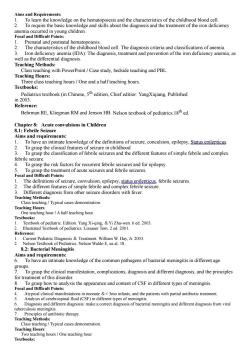
Aims and Requiremeniesis and the characteristics of the childhood blood cellowledgeonthehematopolearntheTo require the basic knowledge and skills about the diagnosis and the treatment of the iron deficiencpungchildrenFocal and Difficult PointsPrenatal and postnatal hematopoiesishcharatthhildboodllhediaoscierandclassatiomciency anemia (IDA):The diagnosis, treatment and prevention of theiron deficiencyanemia, aswell asthedifferentialdiagnosisTeachingMethodng with PowerPoint / Case study, bedside teaching and PBLClassTeaching HoursThree class teaching hours / One and a half teaching hours.Textbooks:Pediastxo(heditiohdioYngqiang,Pbihin2003ReferenceBehrman RE, Kliegman RM and Jenson HB. Nelson textbook of pediatrics.18th ed.Chaptulsions in ChildrenAcute8.1: FebrileAims and reguirementsTo have an intimate knowledge of the definitions of seizure, conculsion, epilepsy, Status epilepticusTo grasp the clinical features of seizure in childhood grasp the classification of febrile seizures and the different features of simple febrile and complexfebrile seizuTograsptheriskfactorsforreurent febrileseizuresandforepilepsysp the treatment of acute seizures and febrile seizureFocal and DiThe definitions of seizure, convulsion, epilepsy, status epilepticus, febrile seizures.The different features of simple febrile and complex febrile seizureDifferent diagnosis from other seizure disorders withfeveTeaching Methodcases demonstration.ng/TvpioTeaching Hourne teaching hour /Ahalf teaching hour.Textbook of pediatric.Edition.Yang Xi-qing.&Yi Zhu-wen.6 ed.2003Illustrated Textbook of pediatrics.Lissauer Tom.2 ed.200Referencsis & Treatment. William W. Hay, Jr.2003atricNelsonTextbokofPediatricsNelsonWaldoEeaal.8.2: Bacterial MeningitisAims and requirements:To have an intimate knowledge ofthe common pathogens of bacterial meningitis in different agegroupss, diagnosis and different diagnosis, and the principle:for treatment of this disograsphowtoanalysistheappearanceandcontentof CSFindifferenttypesofmeningitisFocal and Difficult PointsAtypicalclinicalmanifestatnneonate&<3mo infants,and thepatients withpartial antibiotictreatmentDiagnosisanddifferentdiagnosismakeacorrectdiagnosisofbacterialmeningitisanddifferentdiagnosisfromviraluberculomeningitibiotictherapyTeaching Methodslassteaching/Typical casesdemonstrationTeachingwo teaching hours /One teaching hourTextbooks:
Aims and Requirements: 1. To learn the knowledge on the hematopoiesis and the characteristics of the childhood blood cell. 2. To require the basic knowledge and skills about the diagnosis and the treatment of the iron deficiency anemia occurred in young children. Focal and Difficult Points: 1. Prenatal and postnatal hematopoiesis. 2. The characteristics of the childhood blood cell. The diagnosis criteria and classifications of anemia. 3. Iron deficiency anemia (IDA): The diagnosis, treatment and prevention of the iron deficiency anemia; as well as the differential diagnosis. Teaching Methods: Class teaching with PowerPoint / Case study, bedside teaching and PBL. Teaching Hours: Three class teaching hours / One and a half teaching hours. Textbooks: Pediatrics textbook (in Chinese, 5th edition, Chief editior: YangXiqiang, Published in 2003. Reference: Behrman RE, Kliegman RM and Jenson HB. Nelson textbook of pediatrics.18th ed. Chapter 8: Acute convulsions in Children 8.1: Febrile Seizure Aims and requirements: 1. To have an intimate knowledge of the definitions of seizure, conculsion, epilepsy, Status epilepticus. 2. To grasp the clinical features of seizure in childhood 3. To grasp the classification of febrile seizures and the different features of simple febrile and complex febrile seizure. 4. To grasp the risk factors for recurrent febrile seizures and for epilepsy. 5. To grasp the treatment of acute seizures and febrile seizures. Focal and Difficult Points: 1. The definitions of seizure, convulsion, epilepsy, status epilepticus, febrile seizures. 2. The different features of simple febrile and complex febrile seizure. 3. Different diagnosis from other seizure disorders with fever. Teaching Methods: Class teaching / Typical cases demonstration. Teaching Hours: One teaching hour / A half teaching hour. Textbooks: 1. Textbook of pediatric. Edition. Yang Xi-qing, &Yi Zhu-wen. 6 ed. 2003. 2. Illustrated Textbook of pediatrics. Lissauer Tom. 2 ed. 2001. Reference: 1. Current Pediatric Diagnosis & Treatment. William W. Hay, Jr. 2003. 2. Nelson Textbook of Pediatrics. Nelson Waldo E, ea al. 18 . 8.2: Bacterial Meningitis Aims and requirements: 6. To have an intimate knowledge of the common pathogens of bacterial meningitis in different age groups. 7. To grasp the clinical manifestation, complications, diagnosis and different diagnosis, and the principles for treatment of this disorder. 8. To grasp how to analysis the appearance and content of CSF in different types of meningitis. Focal and Difficult Points: 4. Atypical clinical manifestations in neonate &< 3mo infants, and the patients with partial antibiotic treatment. 5. Analysis of cerebrospinal fluid (CSF) in different types of meningitis. 6. Diagnosis and different diagnosis: make a correct diagnosis of bacterial meningitis and different diagnosis from viral tuberculosis meningitis. 7. Principles of antibiotic therapy. Teaching Methods: Class teaching / Typical cases demonstration. Teaching Hours: Two teaching hours / One teaching hour. Textbooks:
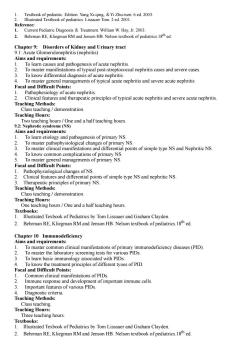
wen.6 ed.2003.Textbook of pediatric.EditiYangXi-qing,&Yi?llustratedTeTom.2ed.200bookofpediatrics.LissaueReferenCurrent PediatriDiagnosis&TreatmentWilliam W.Hay,Jr.2003BehrmanRE,KliegmanRMandJensonHB.Nelsontextbookofpediatrics.18thedDisorders of Kidney and Urinary tractChapter 9:9.1:Acute Glomerulonephritis (nephritis)ms and requiremerandpathogsisofacutenephritisations oftypical post-streptococcal nephritis cases and severe casesTomastermanifestaToknowdifferential diagnosisofacutenephritisneral managements oftypical acute nephritis and severe acute nephritisFocal and Difficult PointsPathophesiology of accute nephritisfeatures and therapeutic principles oftypical acute nephritis and severe acute nephritisTeaching MethodslasingtTeaching HoTwo teaching hours / One and a half teaching hours9.2: Nephrotic syndrome (NS)Aims and requirements:To learn etiology and pathogenesis of primary NSTomasterpathophysiological changesofprimaryNsons and differential points of simple type NS and Nephritic NSTokicatiryNSmanagements of primaryNSFocal and Difficult PointsPathophysiological changes of NS.Clinical features and differential points of simple type NS and nephritic NSTherapeutiprinciples of primary NS.TeachingMeClass teaching / demonstrationTeaching HoursOne teaching hours /One and a half teaching hoursTextbookIllustrated Texbook of Pediatrics by Tom Lissauer and Graham ClaydenBehrman RE, Kliegman RM and Jenson HB. Nelson textbook of pediatrics.18th ed2.Chapter 10 Immunodeficiencyreouremenmanifestations of priunodeficiencydiseases(PID)To master thelaboratory screningtestsforvariousPIDsTo learn basic immunology associated with PIDsToknow thetreatment principles ofdifferent tyoesofPIDFocal and Difficult PointsCommon clinical manifestations of PIDresponse and development of important immune cellsmmne3ImportantfeaturesofvariousPIDsDiagnostic criteriaoMethodClass teachingTeaching Hours:Three teaching hoursTextbooks:1.Illustrated Texbook of Pediatrics by Tom Lissauer and Graham Clayden.Behman RE,KliegmanRMand JenonHBNelon textbookf pediatriced
1. Textbook of pediatric. Edition. Yang Xi-qing, &Yi Zhu-wen. 6 ed. 2003. 2. Illustrated Textbook of pediatrics. Lissauer Tom. 2 ed. 2001. Reference: 1. Current Pediatric Diagnosis & Treatment. William W. Hay, Jr. 2003. 2. Behrman RE, Kliegman RM and Jenson HB. Nelson textbook of pediatrics.18th ed. Chapter 9: Disorders of Kidney and Urinary tract 9.1: Acute Glomerulonephritis (nephritis) Aims and requirements: 1. To learn causes and pathogenesis of acute nephritis. 2. To master manifestations of typical post-streptococcal nephritis cases and severe cases. 3. To know differential diagnosis of acute nephritis. 4. To master general managements of typical acute nephritis and severe acute nephritis Focal and Difficult Points: 1. Pathophesiology of acute nephritis. 2. Clinical features and therapeutic principles of typical acute nephritis and severe acute nephritis. Teaching Methods: Class teaching / demonstration. Teaching Hours: Two teaching hours / One and a half teaching hours. 9.2: Nephrotic syndrome (NS) Aims and requirements: 1. To learn etiology and pathogenesis of primary NS. 2. To master pathophysiological changes of primary NS. 3. To master clinical manifestations and differential points of simple type NS and Nephritic NS. 4. To know common complications of primary NS. 5. To master general managements of primary NS. Focal and Difficult Points: 1. Pathophysiological changes of NS. 2. Clinical features and differential points of simple type NS and nephritic NS. 3. Therapeutic principles of primary NS. Teaching Methods: Class teaching / demonstration. Teaching Hours: One teaching hours / One and a half teaching hours. Textbooks: 1. Illustrated Texbook of Pediatrics by Tom Lissauer and Graham Clayden. 2. Behrman RE, Kliegman RM and Jenson HB. Nelson textbook of pediatrics.18th ed. Chapter 10 Immunodeficiency Aims and requirements: 1. To master common clinical manifestations of primary immunodeficiency diseases (PID). 2. To master the laboratory screening tests for various PIDs. 3. To learn basic immunology associated with PIDs. 4. To know the treatment principles of different tyoes of PID. Focal and Difficult Points: 1. Common clinical manifestations of PIDs. 2. Immune response and development of important immune cells. 3. Important features of various PIDs. 4. Diagnostic criteria. Teaching Methods: Class teaching. Teaching Hours: Three teaching hours. Textbooks: 1. Illustrated Texbook of Pediatrics by Tom Lissauer and Graham Clayden. 2. Behrman RE, Kliegman RM and Jenson HB. Nelson textbook of pediatrics.18th ed
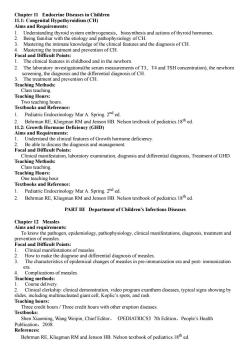
Chapter 1l Endocrine Diseases in Children11.1: Congenital Hypothyroidism (CH)Aims and Requirements:Understanding thyroid system embryogenesis、biosynthesis and actions of thyroid hormonesBeing familiar with the etiology and pathophysiology ofCinical features and the diagnosis of CH.Mastering the intimateknowledge oftheatment and prevention of CHMasterinotFocalarndDifficultPoiThe clinical features in childhood and in the newborn2The laboratory investigationseasurements of T3.T4 and TSH concentration),the newborneserum.mIthediferential diagnosis of CH.The treatment and prevention of CHTeaching MethodsClass teaching.Teaching Hours:eachinghouTextbooks and ReferencePediatric Endocrinology Mar A. Spring. 2nd edRE,KnRMand1 HB. Nelsoics.18th ed1.2: Growth Hone Deficiency (GHD)Aims and RecremenUnderstand the clinical features of Growth hormone deficiency.Beabletodiscuss the diagnosis and managementFocal and Difficult PointsClinical manifestation, laboratory examination, diagnosis and differential diagnosis, Treatment of GHDTeaching MetthodsClass teaching..Teaching HoursTextbooks and ReferencePediatric Endocrinology Mar A. Spring. 2nd ed1.Behrman RE, Kliegman RM and Jenson HB. Nelson textbook of pediatrics.18th edPART III Department of Children's Infectious DiseasesChapter 12 MeaslesAims and requirementToknow thepathogen,epidemiologypathophysiology,clinical manifestations, diagnosis,treatment andoreverFocal and Difficult Pointslinical manifestationsof measlesHow to make the diagnose and differential diagnosis of measles.The characteristics of epidemical changes of measles in pre-immunization era and post- immunizationeraComplicationsof measlesTeaching methods:olurselivericalclereases,typical signs showingbyslides, including multinucleated giant cell, Koplic's spots, and rash.Teaching houThree credit hours / Three credit hours with other eruption diseasesTextbooks:Shen Xiaoming, Wang Weipin, ChiefEditor,《PEDIATRICS》 7th Edition, People's HealthPublication,2008ReferencesBehrman RE, Kliegman RM and Jenson HB. Nelson textbook of pediatrics.18th ed
Chapter 11 Endocrine Diseases in Children 11.1: Congenital Hypothyroidism (CH) Aims and Requirements: 1. Understanding thyroid system embryogenesis、biosynthesis and actions of thyroid hormones. 2. Being familiar with the etiology and pathophysiology of CH. 3. Mastering the intimate knowledge of the clinical features and the diagnosis of CH. 4. Mastering the treatment and prevention of CH. Focal and Difficult Points: 1. The clinical features in childhood and in the newborn. 2. The laboratory investigations(the serum measurements of T3、T4 and TSH concentration), the newborn screening, the diagnosis and the differential diagnosis of CH. 3. The treatment and prevention of CH. Teaching Methods: Class teaching. Teaching Hours: Two teaching hours. Textbooks and Reference: 1. Pediatric Endocrinology Mar A. Spring. 2nd ed. 2. Behrman RE, Kliegman RM and Jenson HB. Nelson textbook of pediatrics.18th ed. 11.2: Growth Hormone Deficiency (GHD) Aims and Requirements: 1. Understand the clinical features of Growth hormone deficiency. 2. Be able to discuss the diagnosis and management. Focal and Difficult Points: Clinical manifestation, laboratory examination, diagnosis and differential diagnosis, Treatment of GHD. Teaching Methods: Class teaching. Teaching Hours: One teaching hour. Textbooks and Reference: 1. Pediatric Endocrinology Mar A. Spring. 2nd ed. 2. Behrman RE, Kliegman RM and Jenson HB. Nelson textbook of pediatrics.18th ed. PART Ⅲ Department of Children’s Infectious Diseases Chapter 12 Measles Aims and requirements: To know the pathogen, epidemiology, pathophysiology, clinical manifestations, diagnosis, treatment and prevention of measles. Focal and Difficult Points: 1. Clinical manifestations of measles. 2. How to make the diagnose and differential diagnosis of measles. 3. The characteristics of epidemical changes of measles in pre-immunization era and post- immunization era. 4. Complications of measles. Teaching methods: 1. Course delivery. 2. Clinical clerkship: clinical demonstration, video program exanthem diseases, typical signs showing by slides, including multinucleated giant cell, Koplic’s spots, and rash. Teaching hours: Three credit hours / Three credit hours with other eruption diseases. Textbooks: Shen Xiaoming, Wang Weipin, Chief Editor,《PEDIATRICS》7th Edition,People’s Health Publication,2008. References: Behrman RE, Kliegman RM and Jenson HB. Nelson textbook of pediatrics.18th ed
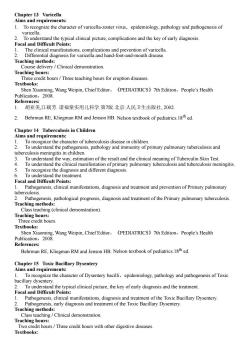
Chapter 13 VaricellaAims and requirementsTo recognize the character of varicella-zoster virus,epidemiology,pathology and pathogenesis ofvaricella.o understand the typical clinical picture, complications and the key of early diagnosisFocal and Difficult Pointheclinical manifestations,complicationsandpreventionof varicellagnosis forvaricella and hand-foot-and-mouth disease.aCourse delivery/Clinical demonstration.Teaching hourThree credit hours/Three teaching hours for eruption diseasesTextbooks:Shen Xiaoming, Wang Weipin, ChiefEditor,《PEDIATRICS》7th Edition, People's HealthPublication, 2008References胡亚美,江载芳.诸福棠实用儿科学.第7版.北京:人民卫生出版社,2002..BehmanRE,Kliegman RM and JensonHBNelson textbookof pediatrics8edChapt4 Tuheculosis in ChildrerAims and requiementTo recognize the character of tuberculosis disease in childrenTo understand the pathogenesis, pathology and immunity of primary pulmonary tuberculosis anotuberculosis meningitis in children.,estimation of the result and the clinical meaning of Tuberculin SkinTesounderstandthewTo understand the clinical manifestation of primary pulmonary tuberculosis and tuberculosis meningitisecognizethediagnosis and different diagnosismerFocaldDiffgenesis,clinical manifestations,diagnosis and treatment and prevention of Primary pulmonartuberculosisPathogenesis, pathological prognosis, diagnosis and treatment of the Primary pulmonary tuberculosisTeaching methodsClass teaching (clinical demonstration).Teaching hourhreecredit hoursTextbooks:Shen Xiaoming,Wang Weipin,ChiefEditor,《PEDIATRICS》thEdition,People'sHealthPublication, 2008ReferencesBehman RE, Kliegman RM and Jenson HB.Nelson textbookof pediatrics.8thedChapter 15 Toxic Bacillary DysenteryAims and requirementsTorecognize the character ofDysentery bacilli, epidemiology, pathology and pathogenesis of Toxicbacillary dysenterthetypical clinical picture,thekey of early diagnosis and the treatmentFocal and DiffiutPathogenesis, clinical manifestations, diagnosis and treatment of the Toxic Bacillary Dysenteryathogens, early diagnosis and treatment of the Toxic Bacillary DysenteryTeaching methodsClass teaching / Clinical demonstration.Teaching hours:Two credit hours / Three credit hours with other digestive diseases.Textbooks:
Chapter 13 Varicella Aims and requirements: 1. To recognize the character of varicella-zoster virus,epidemiology, pathology and pathogenesis of varicella. 2. To understand the typical clinical picture, complications and the key of early diagnosis. Focal and Difficult Points: 1. The clinical manifestations, complications and prevention of varicella. 2. Differential diagnosis for varicella and hand-foot-and-mouth disease. Teaching methods: Course delivery / Clinical demonstration. Teaching hours: Three credit hours / Three teaching hours for eruption diseases. Textbooks: Shen Xiaoming, Wang Weipin, Chief Editor,《PEDIATRICS》7th Edition,People’s Health Publication,2008. References: 1. 胡亚美,江载芳. 诸福棠实用儿科学.第7版.北京:人民卫生出版社, 2002. 2. Behrman RE, Kliegman RM and Jenson HB. Nelson textbook of pediatrics.18th ed. Chapter 14 Tuberculosis in Children Aims and requirements: 1. To recognize the character of tuberculosis disease in children. 2. To understand the pathogenesis, pathology and immunity of primary pulmonary tuberculosis and tuberculosis meningitis in children. 3. To understand the way, estimation of the result and the clinical meaning of Tuberculin Skin Test. 4. To understand the clinical manifestation of primary pulmonary tuberculosis and tuberculosis meningitis. 5. To recognize the diagnosis and different diagnosis. 6. To understand the treatment. Focal and Difficult Points: 1. Pathogenesis, clinical manifestations, diagnosis and treatment and prevention of Primary pulmonary tuberculosis. 2. Pathogenesis, pathological prognosis, diagnosis and treatment of the Primary pulmonary tuberculosis. Teaching methods: Class teaching (clinical demonstration). Teaching hours: Three credit hours. Textbooks: Shen Xiaoming, Wang Weipin, Chief Editor,《PEDIATRICS》7th Edition,People’s Health Publication,2008. References: Behrman RE, Kliegman RM and Jenson HB. Nelson textbook of pediatrics.18th ed. Chapter 15 Toxic Bacillary Dysentery Aims and requirements: 1. To recognize the character of Dysentery bacilli,epidemiology, pathology and pathogenesis of Toxic bacillary dysentery. 2. To understand the typical clinical picture, the key of early diagnosis and the treatment. Focal and Difficult Points: 1. Pathogenesis, clinical manifestations, diagnosis and treatment of the Toxic Bacillary Dysentery. 2. Pathogenesis, early diagnosis and treatment of the Toxic Bacillary Dysentery. Teaching methods: Class teaching / Clinical demonstration. Teaching hours: Two credit hours / Three credit hours with other digestive diseases. Textbooks:
按次数下载不扣除下载券;
注册用户24小时内重复下载只扣除一次;
顺序:VIP每日次数-->可用次数-->下载券;
- 《临床生物化学》课程教学资源(PPT课件)第十九章 自动临床生物化学分析仪的应用及评价.ppt
- 《临床生物化学》课程教学资源(PPT课件)第十八章 治疗药物浓度监测.ppt
- 《临床生物化学》课程教学资源(PPT课件)第十七章 妊娠的生物化学检验.ppt
- 《临床生物化学》课程教学资源(PPT课件)第十六章 肿瘤标志物的生物化学检验.ppt
- 《临床生物化学》课程教学资源(PPT课件)第十五章 神经系统疾病的生物化学检验.ppt
- 《临床生物化学》课程教学资源(PPT课件)第十四章 消化系统疾病的生物化学检验.ppt
- 《临床生物化学》课程教学资源(PPT课件)第十三章 内分泌疾病的生物化学检测.ppt
- 《临床生物化学》课程教学资源(PPT课件)第十二章 心血管系统疾病的生物化学检测.ppt
- 《临床生物化学》课程教学资源(PPT课件)第十一章 肾功能损伤的生物化学检验.ppt
- 《临床生物化学》课程教学资源(PPT课件)第十章 肝胆疾病的生物化学检验.ppt
- 《临床生物化学》课程教学资源(PPT课件)第九章 营养状况的评估及的生物化学监测.ppt
- 《临床生物化学》课程教学资源(PPT课件)第八章 微量元素与维生素异常的生物化学检验.ppt
- 《临床生物化学》课程教学资源(PPT课件)第七章 骨代谢紊乱及相关元素的生物化学检验.ppt
- 《临床生物化学》课程教学资源(PPT课件)第六章 电解质和酸碱平衡紊乱的生物化学检验.ppt
- 《临床生物化学》课程教学资源(PPT课件)第五章 血浆脂蛋白代谢紊乱的生物化学检验.ppt
- 《临床生物化学》课程教学资源(PPT课件)第四章 糖代谢紊乱的生物化学检验.ppt
- 《临床生物化学》课程教学资源(PPT课件)第三章 血浆蛋白质与含氮化合物的生物化学检验.ppt
- 《临床生物化学》课程教学资源(PPT课件)第二章 生物化学检验中的诊断酶学.ppt
- 《临床生物化学》课程教学资源(PPT课件)第一章 绪论.ppt
- 《临床生物化学》课程教学资源(实验指导)第18章 临床化学实验室基础.doc
- 《儿科学》课程教学资源(授课教案)07 Bronchopneumonia.doc
- 《儿科学》课程教学资源(授课教案)06 Hypoxic-ischemic Encephalopathy.doc
- 《儿科学》课程教学资源(授课教案)08 Congenital Heart Disease.doc
- 《儿科学》课程教学资源(授课教案)09 Haematopoiesis and Blood Cell Counts.doc
- 《儿科学》课程教学资源(授课教案)03 Nutrition During Childhood.doc
- 《儿科学》课程教学资源(授课教案)02 Growth and Development.doc
- 《儿科学》课程教学资源(授课教案)05 Neonatal Septicemia.doc
- 《儿科学》课程教学资源(授课教案)04 Neonatal Jaundice.doc
- 《儿科学》课程教学资源(授课教案)01 Introduction of Pediatrics.doc
- 《儿科学》课程教学资源(授课教案)25 Scarlet Fever.doc
- 《儿科学》课程教学资源(授课教案)23 Infantile Hepatitis Syndrome.doc
- 《儿科学》课程教学资源(授课教案)22 Infantale Diarrhea and Fluid Therapy.doc
- 《儿科学》课程教学资源(授课教案)24 Mumps.doc
- 《儿科学》课程教学资源(授课教案)18 Primary Pulmonary Tuberculosis.doc
- 《儿科学》课程教学资源(授课教案)21 Chronic Gastritis in Children.doc
- 《儿科学》课程教学资源(授课教案)20 Toxic Bacillary Dysentery.doc
- 《儿科学》课程教学资源(授课教案)19 Tuberculosis Meningitis.doc
- 《儿科学》课程教学资源(授课教案)16 Measles.doc
- 《儿科学》课程教学资源(授课教案)17 Varicella.doc
- 《儿科学》课程教学资源(授课教案)14 Congenital Hypothyroidism.doc
